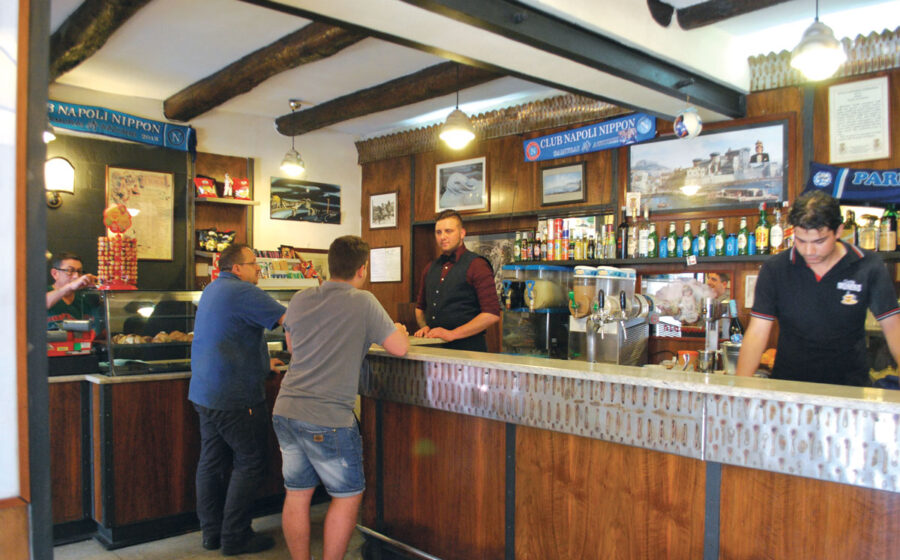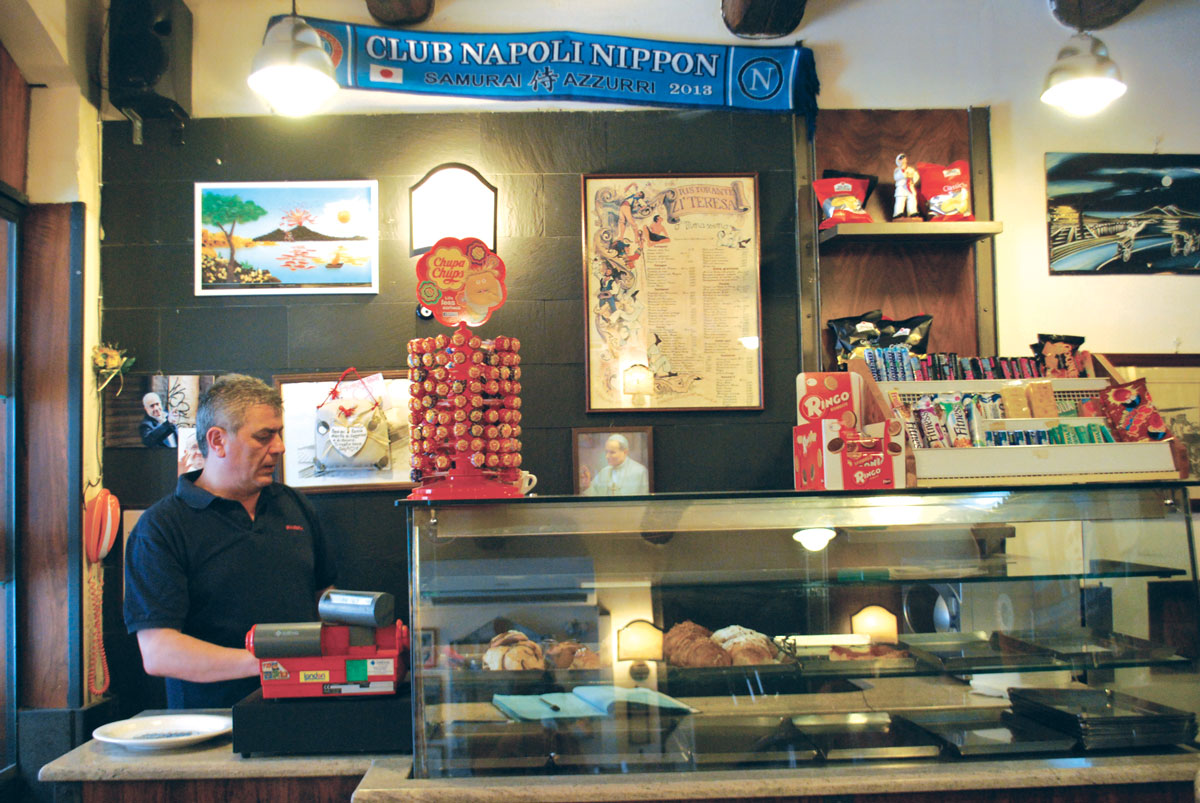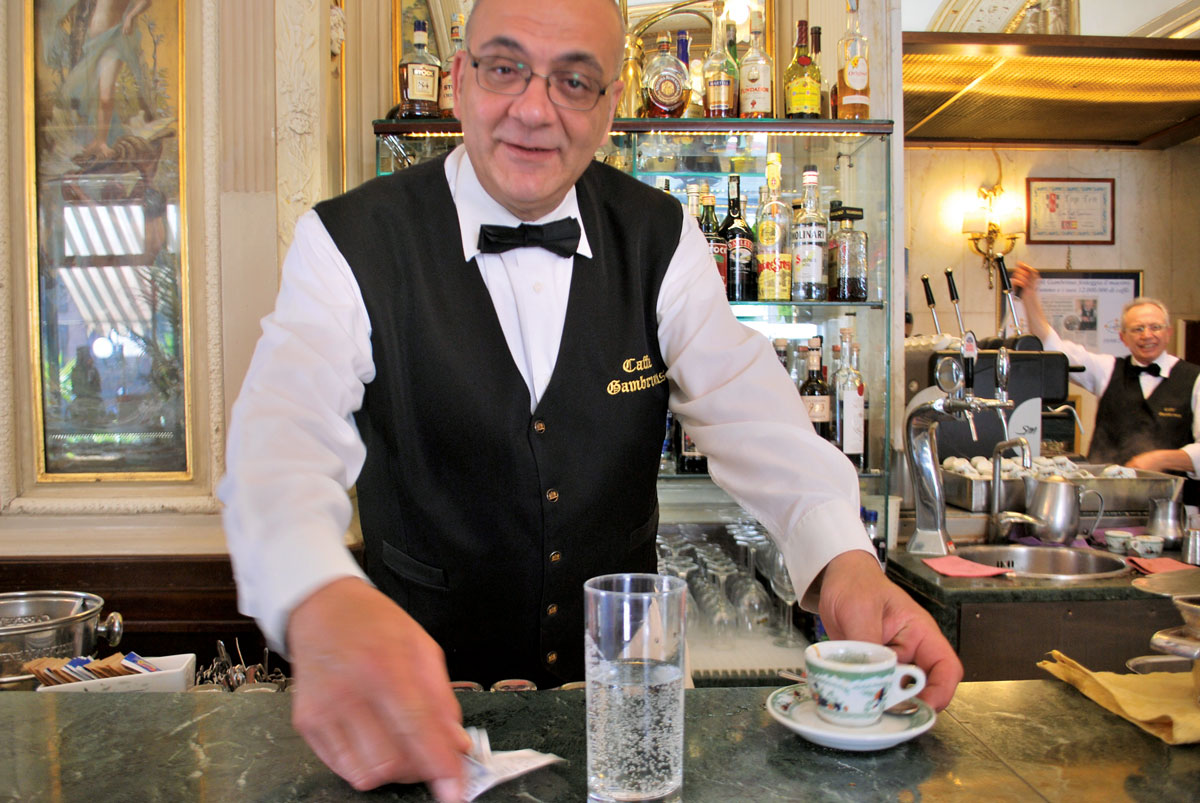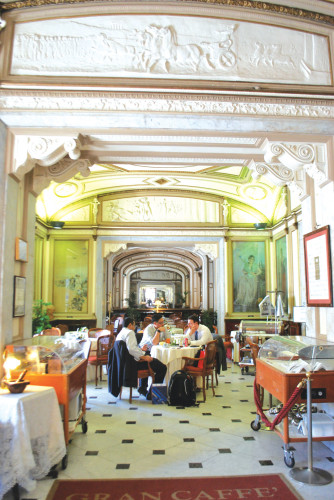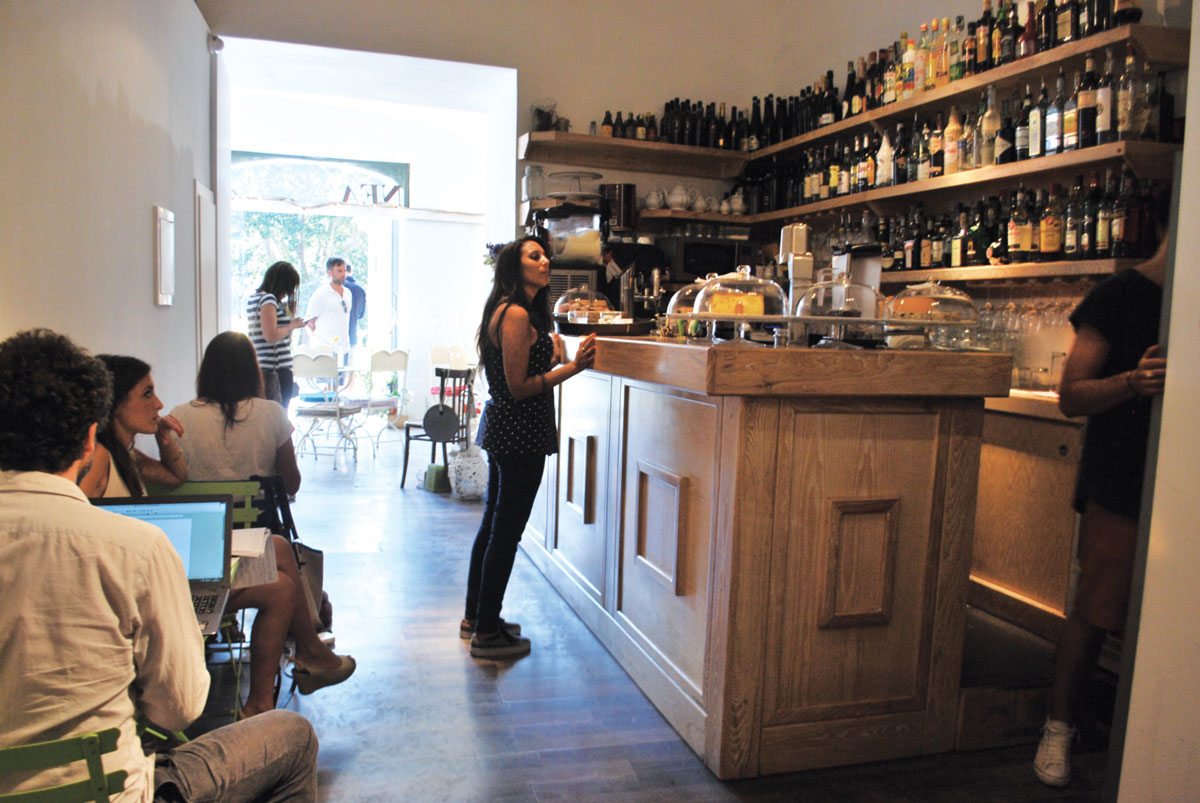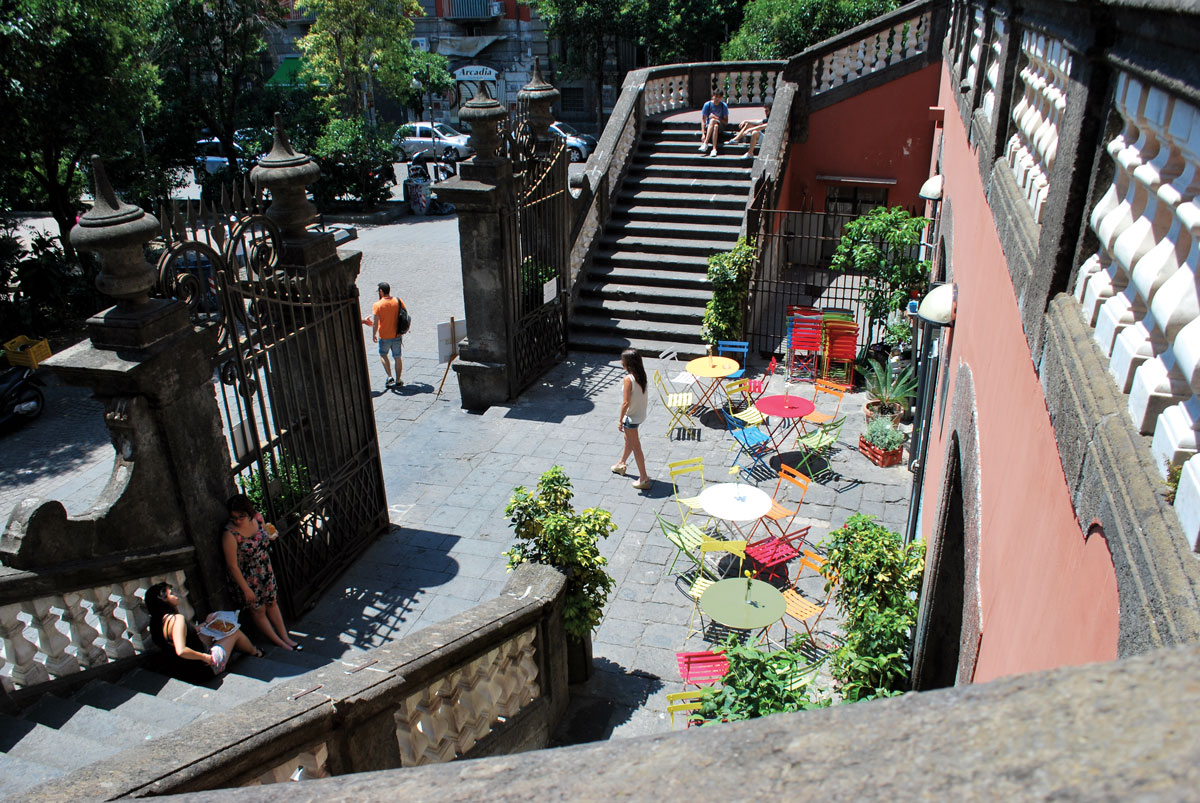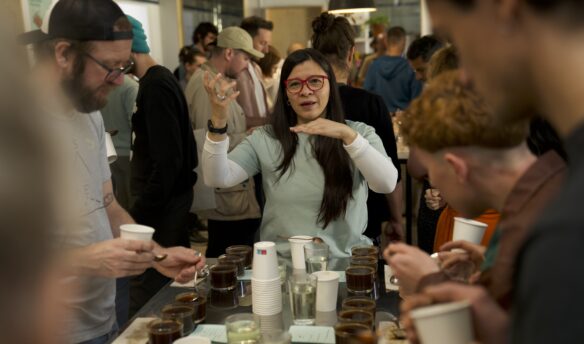[W]hen I finally coax Carmine Alcidi into sharing something about Bar Nilo, the café his family has owned for decades on Spaccanapoli, he gives the pithy, vague, metaphysical, annoyed, dramatic response, “This bar has been our entire life.” Then he wipes some drops of sweat from his forehead with his hand and goes back to the cash register. The weather in Naples at the beginning of summer is already sultry and many locals can hardly stand it. I lean on the counter and ask for a coffee. A young barista, probably Alcidi’s son, spins round in the narrow space between the bar and the coffee machine and he hands me a glass of water. A few seconds later he places a small espresso cup on the saucer in front of me.
My eyes linger on a miniature shrine on the wall dedicated to Maradona, considered without a doubt, at least here, history’s greatest football player. Inside the shrine there’s a frame with a caption reading, playfully sacrilegious, “Miraculous Hair of Saint Maradona.” The relic is surrounded by figurines of other saints clustered in the corners. Flags and shirts of the Napoli soccer team are everywhere, separated only by posters of Totò, another Neapolitan icon.
“In Naples we live for football. Our conversations are based on football, football has a central role in our lives,” says Alcidi. When he says football, he means AS Napoli specifically. “Maradona is a god for every Neapolitan. Football lets us escape from our everyday problems.” Then he says, “Foreigners are often confused by that, but they have to think of Naples as apart from the rest of Italy,” and I’m not sure if he’s talking about just football.
To Alcidi the bar felt like his destiny. He accepted it and deals grumpily with the people strolling in, attracted by the picturesque decorated walls. He neither cares to make his business grow nor to accommodate any other need than providing people with their espresso on the go. Why should he care? Running the bar is what he was intended to do, even before his birth.
The history of this bar on Spaccanapoli—the name of the street cutting old Naples in two—is similar to that of hundreds of Neapolitan bars. It was founded eighty-five years ago by Alcidi’s grandfather and was originally a milk shop. Back then there were no small bars; the only places where you could sip a coffee were the gran caffè and then only if you were a gentleman. The most important one was unquestionably Gambrinus, a beautiful art nouveau café, a short walk from Naples’ esplanade. Before and during the Second World War coffee was a very precious commodity. After the Second World War milk shops slowly turned into coffee shops, expanding coffee houses beyond the upper class. Alcidi’s grandfather followed the trend.
Neapolitans have always loved coffee, despite the difficulties they faced during the 1800s and the first half of the 1900s. The people used to roast coffee in the bassi, the typical ground floor homes in the dark lanes, completely open to the street. Sometimes they also sold it.
The highest concentration of coffee roasters was on Via Roma, the main street. Passersby were transfixed by the aroma coming from these shops, which mingled with the sweet scent from the pastry shops.
“The traditional Neapolitan coffee is the espresso, but every big coffee shop in Naples has invented its own coffee speciality”
Gennaro Ponziani, director of the Gran Caffè Gambrinus, looks back at that period with a little nostalgia. Before becoming part of one of the most prestigious Italian cafés, he worked as a barista for fifty-one years. “I was just eight years old when I started,” he tells me with a sense of inevitability in his voice. “I had to, because there was a lot of poverty in Naples back then. Every café had its own boy bringing artisanal coffee that you used to buy in jute sacks. I worked in almost every bar in Naples before joining Gambrinus.” It was this life-long practice with coffee machines that allowed Ponziani to create his own signature drinks. “The traditional Neapolitan coffee is the espresso, but every big coffee shop in Naples has invented its own coffee speciality,” he says. “I created the Caffè Gegè, Caffè Gambrinus, Caffè alla Nocciola, and Caffè Freddo-Caldo, playing on the infinite variations you can achieve.”
Arturo Sergio, Gambrinus’ administrator, is sitting next to Ponziani under the café’s frescoed ceiling, among the aristocratic furniture. Gambrinus is a little like baroque churches: excessive and with way too many golden friezes, yet somehow managing to be classy. Arturo tells me that people in Naples can drink three to ten coffees a day and still succeed in being easy-going and relaxed (maybe even too relaxed when it comes to getting back to work after their lunch break). “We Neapolitans drink coffee at any time. We are open until three a.m. and at night they still ask us for a cup.”
The conception of drinking a coffee on the run (al volo) is sometimes challenged by younger customers. “Neapolitan coffee is in general very short,” Sergio says. “Coffee here has always been strong and creamy. We don’t want a simple beverage; we want the core of the coffee. Neapolitans have always drunk it that way and they will always do so, but nowadays young people are looking for something different. They want to make an entertainment out of their coffee, as it is with tea. Often they ask for an American coffee, so they can have the chance to smoke two or three cigarettes and take their time to chat.”
The idea of sitting and chatting over a drink is not entirely new to Gambrinus, which has always been a social place. Intellectuals and politicians have come regularly to Gambrinus since the 1800s. Writers have even created works here, Oscar Wilde and Gabriele D’Annunzio being two shining examples.
Not far from Spaccanapoli, in the pivotal square of Piazza Bellini, a new shop called Nea accommodates the growing desire for a convivial place. To get from Spaccanapoli to Piazza Bellini I took the street passing the Conservatory San Pietro a Majella. My walk was accompanied by the voice of an opera singer performing scales mixing with other students working on piano melodies. Nea’s baroque entrance, formed by a double staircase, makes you think of an old-fashioned place, very much like Gambrinus. Yet Nea is the opposite: a white and pristine space with clean-lined, colorful furniture and a wall full of books.
The location is strategic. Located alongside the University of Naples Federico II, Piazza Bellini is the square where young creative people hang out. Even though this area of the city is particularly rich in terms of local history, Nea has a rather international feel to it. It’s a multifunctional space, combining a cozy, rigorously Wi-Fied coffee shop with an art gallery. If you walk past the counter, along a short corridor, you reach a room exhibiting contemporary art.
“In Naples people say, ‘Let’s take a coffee’ just like they would say, ‘Let’s take a pill.’ It’s something you do on the go. Conversely, we like to say, ‘Let’s drink a coffee.’ “
The owners and founders of Nea, Luigi Solito and Bruno La Mura, are passionate about creating a space of cultural aggregation. In person Solito is outgoing and energetic, while La Mura is precise and direct. “In Naples people say, ‘Let’s take a coffee’ just like they would say, ‘Let’s take a pill,’” La Mura says. “It’s something you do on the go. Conversely, we like to say, ‘Let’s drink a coffee.’ Coffee for us is an opportunity to meet, just like it is in other parts of the world. Here at Nea, along with the coffee, you can also visit a high quality exhibition and always find an interesting new catalog to browse through. Sometimes you can also see a live concert or a theatrical performance.”
The combination of culture and sociability belongs to Naples’ identity. Nea’s sweet spot has been to communicate Neapolitan culture globally thanks to an international concept.
La Mura and Solito define themselves as “cultural entrepreneurs” and they are happy to take risks that others in Naples would never dare take. They left their previous jobs and opened the café in the middle of the economic crisis. Spazio Nea, as we see it now, officially opened in 2012. “Many people thought that art was for us a way to sell more coffee. Conversely for us coffee is a way to bring people closer to art,” says Solito. “We give people the chance to see a high-quality show in the exhibition space, then sit at a table and talk about it. We don’t like urging people to buy more drinks or to clear the tables. We like people to stay as long as they want. The coffee can become a pretext to meet, exchange opinions, develop projects.”
Solito explains that Nea is the answer to a need among Neapolitans. “Nea has the genius of simplicity. We don’t even need to define it as a café or a gallery. People come in and appreciate the space according to what they are looking for.” The diverse identity of Piazza Bellini and the many activities at Nea attract a varied clientele. It’s therefore impossible to identify a typical target audience for the space. You can find a fifteen-year-old rocker and an eighty-year-old book lover peacefully sharing the same space. The result is the meeting of people who wouldn’t otherwise do so. “We like to say that you become a Nea ‘user.’ This space shapes you thanks to its cultural and didactic aim,” says La Mura.
Nea is open round-the-clock, all week. Concerts and events are free.
Before Nea other shops had tried a similar format, but failed. Many closed or transformed because they were not able to balance the cultural aspect with the commercial side of running a coffee shop. “It’s not easy to be coherent but we are very happy with what we have done so far,” Solito says. Nea’s achievements are evident. Since its opening, Piazza Bellini and the surrounding area have intensified their cultural connections, creating a local and international network. Nea has become a must for concerts, exhibitions, and book presentations.
Solito and La Mura are happy to see that other spaces similar to Nea are popping up. “That makes us full of joy because it was just what we wanted. We wanted to create a creative atmosphere that would generate momentum. You can’t start a museum and get to a café. You have to start with a café and get to the museum,” Solito says. La Mura says, “That’s the job we’ve done with coffee and that coffee has done for us.”
On my way to the train station, I relish the blending taste of the three coffees I drank respectively at Nea, Gambrinus, and Alcidi’s bar. In a similar amalgam, these three different coffee cultures pleasantly coexist in Naples. Remaining adamant on quality, these shops are enriching the coffee experience in this beautiful city.
—Naima Morelli is a writer based in Rome and Melbourne.



